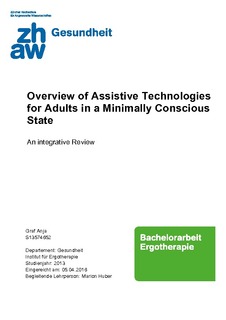Please use this identifier to cite or link to this item:
https://doi.org/10.21256/zhaw-1160Full metadata record
| DC Field | Value | Language |
|---|---|---|
| dc.contributor.advisor | Huber, Marion | - |
| dc.contributor.author | Graf, Anja | - |
| dc.date.accessioned | 2016-10-07T10:34:46Z | - |
| dc.date.available | 2016-10-07T10:34:46Z | - |
| dc.date.issued | 2016 | - |
| dc.identifier.uri | https://digitalcollection.zhaw.ch/handle/11475/1159 | - |
| dc.description.abstract | Background: Through the use of assistive technologies persons in a minimallyconscious state could gain an active engagement role. Objective of the Study: Create an overview of assistive technologies used forrehabilitation interventions, which foster self-determination in adults in a minimallyconscious state. Methods: Through a literature search in the databases CINAHL, PubMed, Web of Science, Cochrane, PsycINFO and Medline publications were selected according to the following criteria: (1) adult persons (18+) with a diagnosis of minimally conscious state, (2) survey of assistive technologies. Findings: Persons in a minimally conscious state can use microswitches to activate an environmental stimulation or a voice output communication aid. Relevance to Clinical Practice: Interventions with assistive technologies are of crucial importance because no other intervention focuses on the acquisition of an active engagement role. Limitations and Recommendations for Further Research: Important results may be missed because publications, which involved beside persons in a minimally conscious state also persons with other disabilities, were excluded. Further research should assess the effects of the devices and investigate other related devices. | de_CH |
| dc.language.iso | de | de_CH |
| dc.publisher | ZHAW Zürcher Hochschule für Angewandte Wissenschaften | de_CH |
| dc.rights | Not specified | de_CH |
| dc.subject | Assistive technology | de_CH |
| dc.subject | Microswitch | de_CH |
| dc.subject | Voice output communication aid | de_CH |
| dc.subject | Minimally conscious state | de_CH |
| dc.subject.ddc | 615.8515: Ergotherapie | de_CH |
| dc.title | Overview of Assistive Technologies for Adults in a Minimally Conscious State : An integrative Review | de_CH |
| dc.type | Thesis: Bachelor | de_CH |
| dcterms.type | Text | de_CH |
| zhaw.departement | Gesundheit | de_CH |
| dc.identifier.doi | 10.21256/zhaw-1160 | - |
| zhaw.originated.zhaw | Yes | de_CH |
| Appears in collections: | Bachelorarbeiten Ergotherapie | |
Files in This Item:
| File | Description | Size | Format | |
|---|---|---|---|---|
| Graf_Anja_ER13_BA.pdf | 872.75 kB | Adobe PDF |  View/Open |
Show simple item record
Graf, A. (2016). Overview of Assistive Technologies for Adults in a Minimally Conscious State : An integrative Review [Bachelor’s thesis, ZHAW Zürcher Hochschule für Angewandte Wissenschaften]. https://doi.org/10.21256/zhaw-1160
Graf, A. (2016) Overview of Assistive Technologies for Adults in a Minimally Conscious State : An integrative Review. Bachelor’s thesis. ZHAW Zürcher Hochschule für Angewandte Wissenschaften. Available at: https://doi.org/10.21256/zhaw-1160.
A. Graf, “Overview of Assistive Technologies for Adults in a Minimally Conscious State : An integrative Review,” Bachelor’s thesis, ZHAW Zürcher Hochschule für Angewandte Wissenschaften, 2016. doi: 10.21256/zhaw-1160.
GRAF, Anja, 2016. Overview of Assistive Technologies for Adults in a Minimally Conscious State : An integrative Review. Bachelor’s thesis. ZHAW Zürcher Hochschule für Angewandte Wissenschaften
Graf, Anja. 2016. “Overview of Assistive Technologies for Adults in a Minimally Conscious State : An integrative Review.” Bachelor’s thesis, ZHAW Zürcher Hochschule für Angewandte Wissenschaften. https://doi.org/10.21256/zhaw-1160.
Graf, Anja. Overview of Assistive Technologies for Adults in a Minimally Conscious State : An integrative Review. ZHAW Zürcher Hochschule für Angewandte Wissenschaften, 2016, https://doi.org/10.21256/zhaw-1160.
Items in DSpace are protected by copyright, with all rights reserved, unless otherwise indicated.